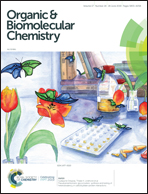A dimethoxypillar[5]arene/azastilbene host–guest recognition motif and its applications in the fabrication of polypseudorotaxanes†
Abstract
Pillar[n]arenes, known as the fifth generation of host macrocycles since 2008, have become a popular topic over the past ten years. Until now, the studies of pillar[n]arenes were mainly focused on pillar[5]arenes owing to their easy synthesis and high yields. In particular, 1,4-dimethoxypillar[5]arene (DMP5), which shows a simple structure, efficient synthesis and high yield, has played important roles in the construction of various advanced supramolecular architectures. However, DMP5 has only displayed host–guest binding properties towards some guests. Therefore, the investigation of the host–guest chemistry of DMP5 should be able to greatly promote the development of pillararene chemistry. Herein, a photosensitive azastilbene derivative was chosen as a neutral guest to study the host–guest binding and stimuli-responsive behavior with DMP5. In addition, the binding behavior of DMP5 towards a series of analogous neutral guest molecules was investigated to study the driving forces of the host–guest interaction between DMP5 and the azastilbene guest. Moreover, the [2]pseudorotaxane based on DMP5 and the azastilbene guest was used to construct a polypseudorotaxane via metal coordination.
![Graphical abstract: A dimethoxypillar[5]arene/azastilbene host–guest recognition motif and its applications in the fabrication of polypseudorotaxanes](/en/Image/Get?imageInfo.ImageType=GA&imageInfo.ImageIdentifier.ManuscriptID=C9OB00862D&imageInfo.ImageIdentifier.Year=2019)
- This article is part of the themed collection: Supramolecular chemistry in OBC


 Please wait while we load your content...
Please wait while we load your content...